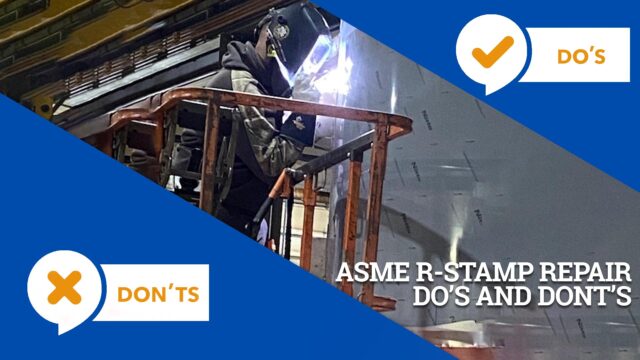
Apache’s Field Service and Quality Assurance team gets frequent inquiries about ASME R-Stamp repairs and alterations. The ASME R-Stamp requirement for a repair is often determined by a consultation and investigation into the pressure zones of the vessel. When assessing a possible ASME R-Stamp repair, here are the Do’s and Don’ts according to Apache’s experts.
DON’Ts
Don’t weld on a pressure vessel. Welding on an ASME vessel must be by qualified and certified welders. In addition to specific techniques for stainless and high alloy material, any welding to a pressure vessel that does not follow ASME code cannot be certified.
Don’t make alterations to a pressure vessel. Even changing a nozzle or piping could change the ASME certification status of a pressure vessel.
Don’t ignore the reduced performance of the vessel. Increased water or steam usage may be a symptom of a crack or defect in the vessel.
DO’s
Do inspect your pressure vessel regularly for stem or fluid leaks. Leakage can be a result of corrosion or cracking in the heating or cooling jacket.
Do report any type of accident with a pressure vessel to your ASME R-Stamp repair organization. Improper thermal cycling, or a tool dropping inside the tank and cause weld and other internal damage.
Do request a repair evaluation from your ASME and R-Stamp certified organization. Apache will work with the customer, NDE firm (if required) and third-party inspector to provide proper repair and documentation for an R-Stamp repair.
Do consider Apache Stainless as your ASME R-Stamp repair partner. Apache’s technicians are fully certified ASME welders. We have been servicing Apache’s ASME tanks and vessels for 40 years. We hold these certifications: ASME U Certificate, ASME UM Certificate, National Board of Boiler & Pressure Inspectors R Certification, and National Board of Boiler & Pressure Vessel Authorization to Register Certificate.
Apache’s group of experienced field services technicians deliver professional services with the goal of the equipment back on-line as soon as possible.
Visit Field Services to learn more.
